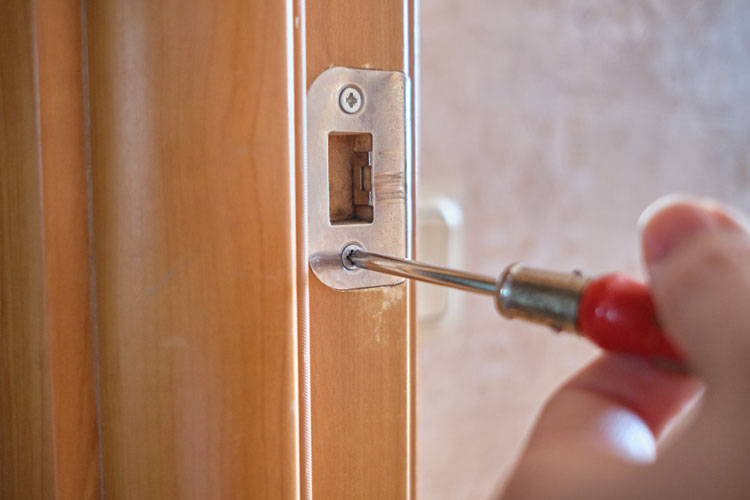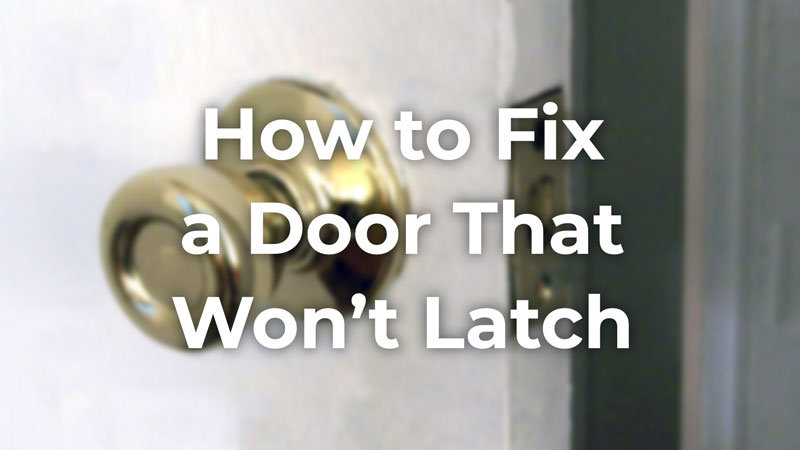Do you have a door that won’t latch properly? A door that you can’t close properly is not only annoying but sometimes it can be a serious security risk too.
Fortunately, fixing a door that won’t latch is not too hard.
Depending on the cause of the problem, you may need to tighten the hinges, adjust the strike plate, lubricate the door lock, or enlarge the strike plate hole. So it’s really not rocket science.
I’ll show you how to do each of these steps in this guide. I’ve gone through these steps countless times before and there has never been a case where I couldn’t fix a door that didn’t stay closed.
Let’s get started!
Tools and Materials You May Need
Tools:
- Screwdriver (flathead and Phillips)
- Hammer
- Chisel
- Drill
- Pencil or tape
- Lipstick or any other kind of marker
- Level
Optional Materials:
- Wood shims
- Wood filler or toothpicks
- Utility knife
- Sandpaper
- Replacement latch assembly
- Replacement strike plate
- Screws
- Paint
Steps to Fix a Door That Won’t Latch
Step 1: Find the Problem
There are a few common causes of a door that won’t latch, such as loose hinges, misaligned strike plate, or narrow strike plate hole. If the latch, the hinges, or the strike plate are loose, bent, or not in the right position, your door won’t stay closed.
To fix a door that does not latch properly, first, you need to identify the source of the problem.
One way to do this is to test where the latch is hitting on the strike plate or door frame using lipstick or a similar marking material.
Follow these steps:
- Apply lipstick to the edge of the latch and close the door gently without turning the knob.
- Open the door and inspect the strike plate and the door jamb. You should see a mark left by the lipstick where the latch made contact.
- If the mark is on the strike plate, check if it is aligned with the hole in the plate. If not, you may need to adjust the position of the strike plate or enlarge the hole.
- If the mark is on the door frame, check if the hinges are loose or misaligned. If so, you may need to tighten or realign the hinges to lift the door slightly.
- If neither of these solutions works, you may have a warped or swollen door that does not fit in the frame. In that case, you may need to sand or plane down the edges of the door or replace it entirely.
Step 2: Move or Widen the Strike Plate
Often the latch does not catch the strike plate because the plate is misaligned with the hole. To fix this, you need to move the strike plate up or down, or widen the hole to accommodate the latch.

Repositioning the Strike Plate
In my experience, a misaligned strike plate is the most common reason why a door won’t stay closed.
To move the strike plate up or down, you will need a Phillips screwdriver, a wood chisel, and a hammer.
- First, unscrew the strike plate from the door frame and set it aside.
- Then, use the chisel and hammer to remove some wood from the top or bottom of the hole, depending on where you want to move the plate. Be careful not to remove too much wood or damage the frame.
- Next, fill in the old screw holes with wood filler or wooden dowels. Let the filler dry completely before proceeding. Alternatively, you can use toothpicks and super glue and then remove the excess part of the toothpicks with a utility knife.
- Finally, align the strike plate with the latch and mark the new screw holes. Drill pilot holes and screw the plate back in place.

Pro Tip
For secure installation, use longer screws if the new holes align closely with the old ones. Opt for 3-inch set screws that firmly bite into the stud, providing superior stability compared to the standard 1-inch screws.
Widening the Strike Plate Hole
To widen the strike plate hole (catch hole), you will need a metal file or a drill.
- First, unscrew the strike plate from the door frame and set it aside.
- Then, use the metal file or drill to enlarge the hole on either side, depending on where the latch is hitting. Be careful not to make the hole too big or damage the door jamb.
- As a next step, smooth out any rough edges with sandpaper or a file.
- Finally, align the strike plate with the latch and screw it back in place.
Here are some tips to help you align the strike plate with the latch:
- Close the door slowly and watch how the latch meets the strike plate. You can also mark the position of the latch with a pencil or tape.
- Use a level or a ruler to make sure the strike plate is horizontal and parallel to the edge of the door.
- Test the door several times after adjusting the strike plate to make sure it closes and locks properly.
Step 3: Adjust the Hinges
If your door is sagging or sticking, you may need to adjust the hinges.
Steps:
- First, check the hinge screws and make sure they are tight. You can use a screwdriver to tighten them if they are loose.
If the screws are stripped or too short, you may need to replace them with longer ones (use 3-inch screws) that fit the hinge holes. - If tightening or replacing the screws does not solve the problem, you may need to shim or sand down under the hinges. This will change the position of the door and make it align better with the frame.
- To shim under a door hinge, you can use thin pieces of cardboard or wood and insert them between the hinge and the door or the frame.
- To sand down under a hinge, you can use sandpaper or a wood file and remove some material from the door or the frame where the hinge is attached.
- Finally, test the door and see if it opens and closes smoothly. You may need to repeat the steps above until you get the desired result.

Be careful not to adjust the hinges too much. If you adjust them too much, you may create gaps between the door and the frame or make the door rub against the floor or the wall.
Step 4: Lubricate or Replace the Latch
Lubricating the Latch
If your latch is sticking or jamming, you may need to lubricate it to make it work smoothly.
To do this, you will need some graphite powder or silicone spray (such as WD-40), which you can find at most hardware stores.
Steps:
- Remove the knob or handle from the door by unscrewing it from the spindle.
- Insert the nozzle of the graphite powder or spray into the keyhole and squeeze gently to apply a small amount of lubricant inside the lock mechanism.
- Turn the key or spindle several times to distribute the lubricant evenly inside the lock.
- Reattach the knob or handle and test the latch. If it still sticks or jams, repeat the process until it works properly.
In most cases, lubrication will help with a stuck door latch, so it also often provides a solution if the latch bolt is not extending fully or if it won’t retract.
Replacing the Latch
If your latch is broken or worn out, you may need to replace it with a new one. To do this, you will need a screwdriver and a new latch kit that matches your door type and size.

Steps:
- Remove the knob or handle from the door by unscrewing it from the spindle.
- Remove the screws that hold the faceplate of the latch on the edge of the door and pull out the latch assembly.
- Insert the new latch assembly into the hole on the edge of the door and align it with the strike plate on the door frame.
- Secure the faceplate of the new latch with screws and make sure it is flush with the edge of the door.
- Reattach the knob or handle and test the latch. If it does not align with the strike plate, adjust it by loosening or tightening the screws on the faceplate.
When choosing a new latch for your door, you should consider these tips:
- Measure the backset of your door, which is the distance from the edge of the door to the center of the knob or handle hole. Most doors have a backset of either 2 3/8 inches or 2 3/4 inches, but some may have a different measurement. Choose a latch kit that matches your backset measurement.
- Check the type of your door, which can be either left-handed or right-handed depending on which way it swings open.
- Choose a latch kit that matches your door type. You can tell if your door is left-handed or right-handed by standing outside and facing it. If the hinges are on your left and it opens inward, it is a left-handed door. If the hinges are on your right and it opens inward, it is a right-handed door.
- Choose a latch kit that matches your door style and finish.
For example, if you have a brass knob or handle, you should choose a brass latch kit. If you have a modern or contemporary style door, you should choose a sleek and simple latch kit. If you have a traditional or classic style door, you should choose a decorative and ornate latch kit.
If you’ve followed the previous steps and the door still won’t latch properly, I recommend that you consult a professional door repair service. They have the expertise and tools to handle complex latch issues effectively.
Preventive Measures: Maintaining Proper Door Functionality
Once you’ve fixed your door latch issue, it’s important to take preventive measures to maintain its functionality and prevent future problems.
Here are my tips:
- Conduct regular inspections of your doors to identify and address minor latch issues promptly.
- Lubricate the latch mechanism periodically to ensure smooth operation.
- Tighten any loose screws on the door hinges and strike plates.
- Avoid excessive force when opening or closing doors, as it can strain the latch mechanism.
- Address any signs of misalignment or settling in your home promptly to prevent latch problems in the future.
By adopting these preventive measures, you can prolong the lifespan of your door’s latch mechanism and avoid inconvenient repairs down the line.
FAQs
Can a door that won’t latch be fixed without professional help?
Yes, many latch issues can be resolved through DIY methods. However, if the problem persists or is more complex, it’s advisable to seek professional assistance.
Why is it important to address a door latch issue promptly?
Promptly addressing a door latch issue ensures the security and functionality of your door. Ignoring the problem can lead to further damage and compromise home security.
Can weather conditions affect the latch mechanism?
Extreme weather conditions, such as humidity or temperature changes, can cause doors to expand or contract, leading to latch problems. Proper maintenance can mitigate these effects.
How often should I inspect my doors for latch problems?
It’s recommended to inspect your doors for latch problems at least once every few months. Regular inspections help identify issues early on.
Are there any DIY temporary fixes for a door that won’t latch?
Yes, if you need a temporary solution, you can use a u003ca href=u0022https://dailyhomesafety.com/can-a-doorstop-prevent-entry/u0022u003edoorstopu003c/au003e or install a door closer to keep the door securely closed until the latch issue is resolved.












